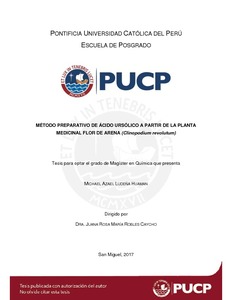| dc.contributor.advisor | Robles Caycho, Juana Rosa María | |
| dc.contributor.author | Ludeña Huamán, Michael Azael | es_ES |
| dc.date.accessioned | 2017-09-29T21:47:33Z | es_ES |
| dc.date.available | 2017-09-29T21:47:33Z | es_ES |
| dc.date.created | 2017 | es_ES |
| dc.date.issued | 2017-09-29 | es_ES |
| dc.identifier.uri | http://hdl.handle.net/20.500.12404/9421 | |
| dc.description.abstract | El ácido ursólico es un triterpeno pentacíclico que pertenece al grupo de los terpenoides y debido a sus diversas actividades farmacológicas, relacionadas con sus efectos hepatoprotectores, anti-oxidante, anti-inflamatorio y antitumoral, es objeto de un gran interés científico. Esta investigación tuvo como finalidad obtener ácido ursólico de alta pureza de una manera fácil, rápida y económica a partir de la especie clinopodium revolutum conocida comercialmente como flor de arena. El proceso comenzó con la obtención del extracto de las hojas secas, a partir de ello se aisló ácido ursólico y se usó la técnica de recristalización para la separación y purificación. Finalmente se realizó análisis espectroscópicos de IR y RMN mono y bidimensional para caracterizar la molécula. Mediante la técnica de UPLC se determinó el contenido total y el porcentaje de pureza. Entre los resultados más importantes del estudio se determinó que dicha especie es la que presenta mayor cantidad (4,864 %) de ácido ursólico entre las especies de la familia Lamiaceae. Entre las conclusiones se destaca que dicha planta medicinal Clinopodium revolutum conocida y comercializada con el nombre de flor de arena o té indio endémica del Perú, cultivada principalmente en las regiones de Huánuco y Cajamarca, resultó ser una importante biofuente de ácido ursólico, no solo por su alto contenido sino también por los métodos fáciles, económicos y reproducibles con las que se logró obtener cristales de ácido ursólico puro mediante la técnica de recristalización. | es_ES |
| dc.description.abstract | Ursolic acid is a pentacyclic triterpene that belongs to the group of terpenoids and for its variety of pharmacological activities, related to their hepatoprotective effects, anti-oxidant, anti-inflammatory and anti-metastasis, is a subject of great scientific interest. This research aimed to obtain high purity ursolic acid in an easy, fast and economical way from the Clinopodium revolutum species known commercially as flor de arena. The process began with obtaining the extract of the dried leaves, from which ursolic acid was isolated using and the recrystallization technique was used for separation and purification. Finally we performed spectroscopic analyzes of IR and mono and twodimensional NMR to characterize the molecule. The total content and percentage of purity were determined by the UPLC technique. Among the most important results of the study, it was determined that this species is the one with the highest amount (4.864%) of ursolic acid among species of the Lamiaceae family. Among the conclusions, it is noted that this medicinal plant known as Clinopodium revolutum and marketed under the name of flor de arena or té indio endemic of Peru, grown mainly in the regions of Huánuco and Cajamarca, proved to be an important biofuente of ursolic acid, not only for its high content but also by the easy, economical and reproducible methods with which crystals of pure ursolic acid were obtained by the recrystallization technique. | es_ES |
| dc.description.uri | Tesis | es_ES |
| dc.language.iso | spa | es_ES |
| dc.publisher | Pontificia Universidad Católica del Perú | es_ES |
| dc.rights | info:eu-repo/semantics/openAccess | es_ES |
| dc.rights.uri | http://creativecommons.org/licenses/by-nc-nd/2.5/pe/ | * |
| dc.subject | Ácido ursólico | es_ES |
| dc.subject | Resonancia magnética nuclear | es_ES |
| dc.subject | Cromatografía líquida | es_ES |
| dc.subject | Productos naturales | es_ES |
| dc.title | Método preparativo de ácido ursólico a partir de la planta de medicinal Flor de arena (Clinopodium revolutum) | es_ES |
| dc.type | info:eu-repo/semantics/masterThesis | es_ES |
| thesis.degree.name | Magíster en Química | es_ES |
| thesis.degree.level | Maestría | es_ES |
| thesis.degree.grantor | Pontificia Universidad Católica del Perú. Escuela de Posgrado | es_ES |
| thesis.degree.discipline | Química | es_ES |
| renati.discipline | 531057 | es_ES |
| renati.level | https://purl.org/pe-repo/renati/level#maestro | es_ES |
| renati.type | http://purl.org/pe-repo/renati/type#tesis | es_ES |
| dc.publisher.country | PE | es_ES |
| dc.subject.ocde | https://purl.org/pe-repo/ocde/ford#1.04.00 | es_ES |






